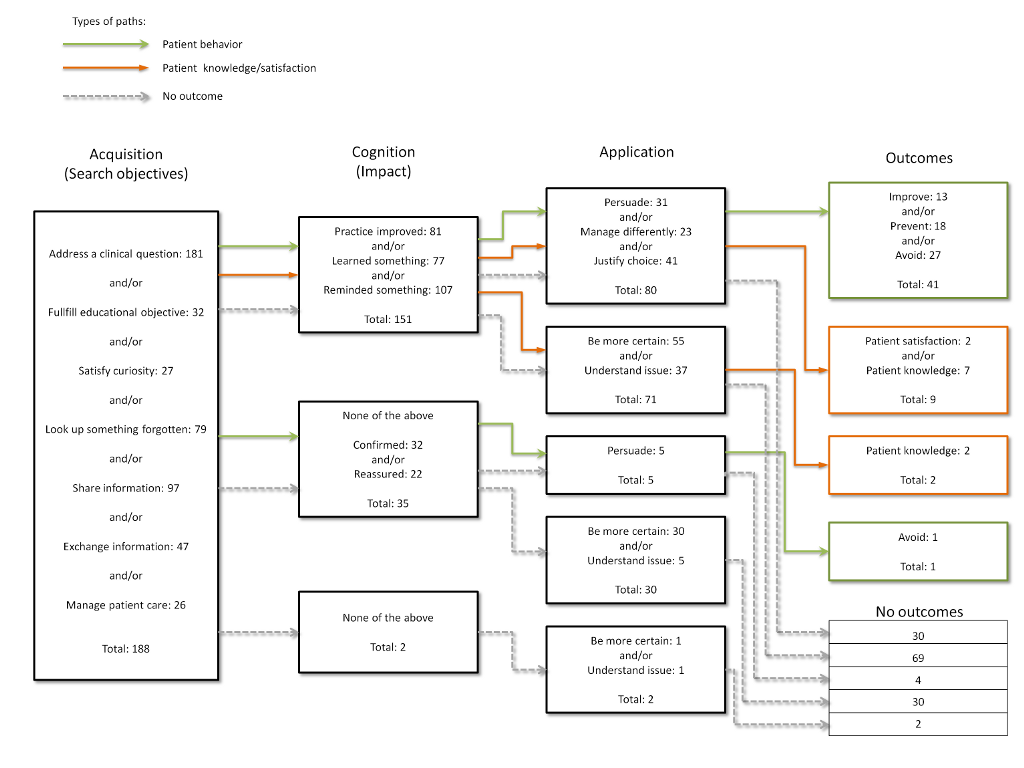This website presents detailed research findings to support the following paper: Pierre Pluye, Roland M Grad, Janique Johnson-Lafleur, Vera Granikov, Michael Shulha, Bernard Marlow, & Ivan Ricarte (2013). The Number Needed to Benefit from Information (NNBI): Proposal from a mixed methods research study with practicing family physicians. Annals of Family Medicine. 11(6):559-67. DOI: 10.1370/afm.1565. PMID: 24218380 [PubMed] Free full-text: http://www.annfammed.org/content/11/6/559.long
The following diagram organizes clinical vignettes by type of health outcome. Click on one of the outcome boxes to display the corresponding clinical vignettes. See the summary below for more information.

| Legend (using items from the Information Assessment Method) |
|---|
| ACQUISITION (interviewee’s search objective) |
| To address a clinical question about a specific patient |
| To fulfill a personal educational objective |
| To satisfy curiosity or for personal interest |
| To look up something I had forgotten |
| To share information with a patient, their family, or home health aides |
| To exchange information with other health professionals (e.g., a colleague) |
| To manage aspects of patient care with other health professionals |
| COGNITION (cognitive impact of information on the interviewee) |
| Interviewee's practice was changed and improved |
| Interviewee learned something new |
| This information confirmed the interviewee did the right thing |
| The interviewee was reassured |
| They were was reminded of something they already knew |
| APPLICATION (interviewee’s information use) |
| The interviewee used this information to persuade the patient, or to persuade other health professionals to make a change |
| As a result of this information the interviewee managed this patient differently |
| The interviewee had several options for this patient or did not know what to do, and used this information to justify a choice |
| They thought they knew what to do, and used this information to be more certain about the patient management |
| They used this information to better understand a particular issue related to the patient |
| OUTCOMES (patient health benefits) |
| This information helped to improve the patient’s health status, functioning or resilience |
| This information helped to prevent a disease or worsening of disease for the patient |
| This information helped to avoid unnecessary or inappropriate treatment, diagnostic procedures, preventative interventions or a referral |
| This information helped to increase the patient’s satisfaction about a treatment, diagnostic procedure or preventative intervention |
| This information helped to increase the patient’s knowledge |
| Numbers in the diagram represent the number of cases. |
Pierre Pluye, McGill University, Department of Family Medicine, Montreal, Canada,
Roland Grad, McGill University, Department of Family Medicine, Montreal, Canada
Janique Johnson-Lafleur, Information Technology Primary Care Research Group (ITPCRG), Montreal, Canada
Vera Granikov, Information Technology Primary Care Research Group (ITPCRG), Montreal, Canada
Michael Shulha, Information Technology Primary Care Research Group (ITPCRG), Montreal, Canada
Bernard Marlow, College of Family Physicians of Canada, Mississauga, Canada
Ivan Luiz Marques Ricarte, University of Campinas, School of Electrical and Computer Engineering, Campinas, Brazil